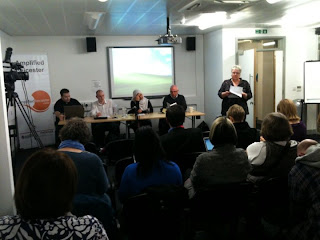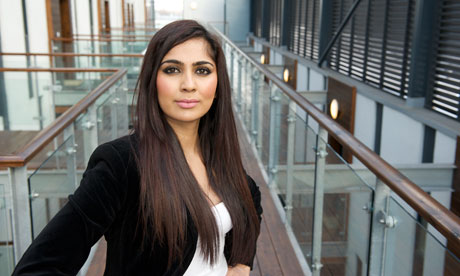I came across Maurice Glasman in a Guardian profile some months back. Not knowing anything at all about the man or his thinking until then, my first reaction was, "Now that's the kind of person who should be in the House of Lords!" Since then, I've followed him with interest in the press, online and in social media and that reaction has only grown stronger. So I was delighted to receive this invitation to meet him at close quarters. Rather than try and introduce Lord Glasman properly to you here and give all the context to the visit, I'd prefer to concentrate on what was said and done today. For background stuff and useful links, I direct you to Dr Miles Weaver's blog (which contains a link to that Guardian article mentioned above).
So, there are around 30 of us at this afternoon session in the
I should make it clear that, while Lord Glasman is a Labour peer with a high profile role in helping reshape the party's political philosophy, this is not a Labour meeting. There are several Labour activists here, naturally, but there are many people of different political persuasions, as well as some who prefer to keep their affiliation to themselves. Certainly when we're given the opportunity to introduce ourselves, to say why we're here and what we hope to get out of the meeting, many voice the hope of having someone give them an authoritative definition of "Big Society", without showing apparent awareness that our guest might be in opposition to it.
The theme of this session is actually "The Big Society vs The Good Society" though that doesn't assume the two are mutually exclusive. Lord Glasman tells us that his task is to help define the "Good Society". He's not ideologically opposed to the idea of Big Society, but believes it's incapable of delivering on what it might promise if it must operate in an environment where everything is commodified, including (since we're in a university) learning. He's just as critical of Labour's position on community, in that it allowed both public and private sectors to run amok during its period in office, exacerbating a trend to reduce everything to dependency on material means. This has led to the position where, if someone has an idea that they believe could be good for the community, their first instinct is to apply for a grant, rather than try to engage, enlist, enthuse and recruit others. This has undermined an older, more traditional form of ownership and control by active members or subscribers. Our society has become polarised so that virtually all of us are involved in, engaged with, are served (or are serving) one sector or the other - public or private - and they're seen as mutually antagonistic and incompatible. We're now hostage to the idea that each of these holds the other back; that for one to flourish the other must wither and die. The Voluntary and Community Sector is caught between the two, liable to be wounded whichever one falls.
An action is something that generates a reaction. The action is in the reaction. To be effective activists, we should never do anything that doesn't generate reaction. Our culture keeps us busy with activities that don't get reactions.
This leads on to Lord Glasman expressing his ambivalence about the recent march in
Society itself can be demoralised. To counter this, we need to engage with each other on three levels:
Relationships
Lord Glasman emphasises the primacy of relational culture, of one-to-one links. Neglect of this vital aspect to our collective lives (in all sectors) has led to a stifling bureaucracy. Building a genuine network based on trust and mutual support is the most important and - and most powerful - thing we can do.
Power
We must discover ways to be more powerful in the world, not to be victimised - which is being a fantasist (victimised, powerless, disappointed, defeated). Friendship, trust, association are the only means to power for those who don't have access to big money
Institutions
Every institution has a vocation, which brings with it ethical considerations. A vocation is not the same as a career. It brings with it a sense of ethical regard, internal self-regulation. Citizenship is not just about individuals or individualism; it relies on collaboration between individuals and institutions.
There is no genuine community without leadership. To have change, we must have leaders who can work together, who can speak reliably for their communities, congregations and constituencies and who can bring along with them.
While he understands the attraction and convenience of moving things online, Lord Glasman would ask us to beware that by doing stuff on the web, we lose the sense of place. We have to see what it is that we have that makes
My favorite thing that I heard him say all day was a line delivered in a throw away fashion: "When it's all talk and no action, the band splits up."
Come 1520, we head out of the Hugh Aston and gather on the quad along with half a dozen or more friends who are joining us for the walk round various faith centers in this part of the city.
Our first stop is the prayer room of the DMU Islamic Society. There are rather too many of us to fit comfortably in there, so I remain outside.
Second stop on our walkabout is the Jain Centre on
Oxford Street . We're received at the door by Smita Shah, President of Jain Samaj Europe and Treasurer of Leicester Council of Faiths. Dr Rameshbhai Mehta acts as our main guide round the Centre. I've been here many times (must be a dozen or more now) but the beauty and the spiritual power of this place never palls. For many of those on the visit today, it's their first time here - and their first significant encounter with Jainism and Jains. At the end of our visit, Dr Mehta gives us his formula for Jainism in a nutshell: J is for justice; A is for amity; I is for introspection; N is for nobility.
We move on to the Cathedral, where I manage to buttonhole Lord Glasman for a brief private chat. Just a few minutes, but definitely worthwhile from my point of view. If I'd let the day pass without doing this, I'd have regretted it.
Lord Glasman's final stop is at Guru Nanak Gurdwara in Holy Bones, whence he catches a taxi to the railway station. There are several more stops on the tour as planned, but we're already a long way behind schedule and I have to quit at this point too.




